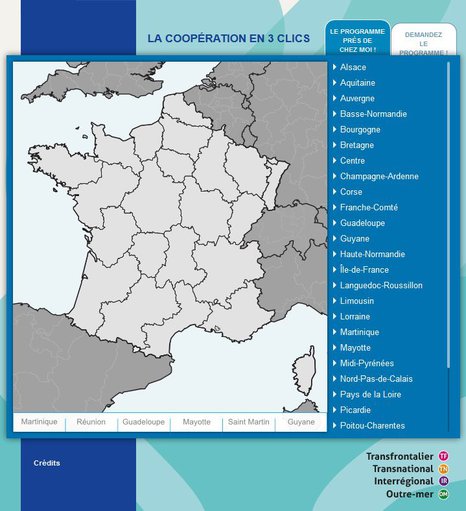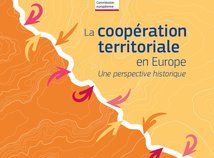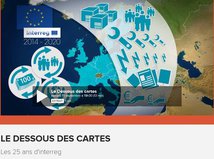European Programmes
Introduction
The European territorial cooperation (ETC) is a key element of the objective of harmonious territorial development and territorial cohesion pursued by the European Union. Through these programmes, the various actors can identify common solutions in areas such as urban, rural and coastal development, the development of economic relations and networking SMEs. The French regions can thus join forces with regions from other Member States to create projects to reduce the border effect.
Published by the European Commission on the occasion of the 25th years of Interreg, this unprecedented brochure “Territorial cooperation in Europe, a Historical Perspective” provides a key to understanding the complexity, richness and diversity of all territorial cooperation in Europe. The MOT realized the 26 maps of the brochure showing the impact of cross-border cooperation on a European and national scale. Click here to download the book.
An Arte programme « Le Dessous des Cartes » was dedicated to the European territorial cooperation on the occasion of its 25th anniversary. For its elaboration, the LEPAC laboratory directed by Jean-Christophe Victor received the support of the Transfrontier Operational Mission. More infos
Presentation of the European territorial cooperation
Since the 2007-2013 programming period, the ETC, which previously came under the Interreg Community Initiative programme, has become a fully-fledged objective of cohesion policy.
European territorial cooperation is built around three stands :
- cross-border cooperation (Interreg A) : financing of projects on either side of a common border;
- transnational cooperation (Interreg B) : financing of projects in larger geographical areas (see also the "macroregions" page) ;
- interregional cooperation (Interreg C) : Interreg Europe, Interact, Urbact and ESPON programmes.

The Lisbon Treaty, which came into force in December 2009, reinforced the legitimacy of regional and local players (subsidiarity) and of the European Union’s territorial approach (territorial cohesion).
According to the Territorial Agenda 2020, which was approved in May 2011 under Hungary’s presidency by the European ministers responsible for spatial planning and territorial development, territorial cooperation initiatives must be focused on long-term territorial cohesion objectives, based on the experience of the Interreg and the integrated macro-regional strategies, such as the pioneering initiatives in the Baltic Sea and Danube regions.
COHESION POLICY 2014-2020
For the 2014-2020 period, the Cohesion policy is structured around two major objectives: "Investment for growth and jobs" and "European Territorial Cooperation".
The architecture of the cohesion policy for this programming period consists of:
- European Regulations,
- a European strategy document, the Common Strategic Framework,
- Binding documents between Member States and the EU, the Partnership Agreements,
- and programme structuring documents, the Operational Cooperation Programmes.
The Regulations relating to the 2014-2020 cohesion policy were adopted on 17 December 2013:
- a regulation laying down common provisions (CPR), which introduces 11 thematic objectives,
- a European Regional Development Fund (ERDF) regulation,
- a European Social Fund (ESF) regulation,
- for the first time, a separate regulation for European Territorial Cooperation (ETC),
- and an EGTC regulation, amending the 2006 regulation (European Grouping of Territorial Cooperation),
- a European Agricultural Fund for Rural Development (EAFRD) regulation,
- a Cohesion Fund regulation.
The main innovation of these texts is the thematic concentration for A and B programmes. In connection with the Europe 2020 strategy, the idea is to encourage programmes to concentrate 80% of the ERDF allocated on four thematic objectives. The aim is to make investments more efficient by avoiding the dispersion of funds. Finally, programmes have also to set up goals to be achieved in order to assess the effectiveness of European investment.
In order to implement a territorial approach, the regulations also provide for the creation of tools such as ITI (integrated territorial investment) and CLLD (community-led local development), which can also be used in the cross-border context and be implemented by EGTC or entities of a similar nature.
Aspects relating to European territorial cooperation must now be systematically included in the Partnership Agreement (see hereafter the partnership agreement of France), whereas this was optional in the previous period.
The Common Strategic Framework (part 1 - part 2) sets out common provisions for the funds it covers (cohesion policy, rural development and maritime and fisheries policy). Its objective is to help establish the strategic priorities for the programming period 2014-2020 in the Member States and their regions.
The implementation of cohesion policy for the programming period is framed by the European Union's Multiannual Financial Framework (MFF) for the years 2014 to 2020, which was passed on 19 November 2013 by the European Parliament, and finally approved by the Council on 2 December 2013. The sum allocated to European territorial cooperation has been raised for the 2014-2020 programming period to 8,948,260,000 euros (2011 prices).
More information
Partnership agreement and cooperation programmes in France
A national consultation process was launched on 20 December 2012 by the DATAR – (which became the CGET – Commissariat general à l’égalité des territoires in 2014, in English General Commission for Territorial Equality), implemented in parallel with the definition of the operational programmes, to provide input for the French Partnership Agreement. This document defines the strategic priorities in France of the application of the European funds for the 2014-2020 period. In this context, a series of seventeen thematic and territorial consultation seminars were organised, in which the MOT took part in order to highlight the specific aspects of cross-border territories
The French Partnership Agreement was adopted by the European Commission on 8 August 2014, and includes an amount of € 3 021.2 million (ERDF) for European territorial cooperation
More information on the ERDF funds involiving France.
In France, subsequent to the act on modernisation of territorial public action and affirmation of metropolitan areas (MAPAM), the government devolves to the regions, at their request, all or part of the management of the European programmes, either as managing authority or by management delegation.
Programming periods
- Interreg 1990-1993
- Interreg II 1994-1999
- Interreg III 2000-2006
- Interreg IV 2007-2013
- Interreg V 2014-2020 (or "European territorial cooperation" objective): for the "European territorial cooperation" objective, the ERDF supports cross-border, transnational and inter-regional cooperation.
The Cross-border review
On the occasion of the 25th years of Interreg, the European Commission (DG REGIO) carried out an important initiative called « Cross-border Review » between September 2015 and September 2017. The aim of this initiative was to analyse the administrative and legal obstacles that persist along the internal borders of the European Union. It was structured around 3 sequences:
- Conducting a study to draw up a critical inventory of obstacles,
- A public consultation, to which the MOT responded,
- Four expert workshops, in which the MOT participated.




